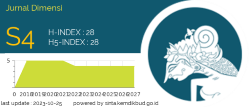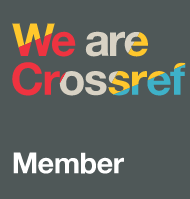PENGARUH METODE JIGSAW DAN KECEMASAN BERBICARA TERHADAP KEMAMPUAN SPEAKING DI PROGRAM STUDI BAHASA INGGRIS UNIVERSITAS RIAU KEPULAUAN THE INFLUENCE OF JIGSAW AND SPEAKING ANXIETY TOWARDS SPEAKING COMPETENCE OF ENGLISH DEPARTMENT STUDENTS OF UNIVERSITAS RIAU KEPULAUAN
Abstract
Penelitian ini bertujuan untuk mengetahui keefektifan metode jigsaw dalam pembelajaran speaking, serta pengaruh dari salah satu aspek psikologis siswa yaitu kecemasan berbicara terhadap kemampuan speaking. Penelitian ini merupakan penelitian kuasi eksperimen yang bertujuan untuk mengetahui apakah ada pengaruh dari metode pembelajaran jigsaw dan faktor kecemasan berbicara terhadap kemampuan speaking siswa. Penelitian ini menggunakan populasi seluruh mahasiswa Prodi Pendidikan Bahasa Inggris, Universitas Riau Kepulauan, Kepulauan Riau dan pemilihan sampel dilakukan dengan tehnik random sampling. Data dikumpulkan dengan menggunakan tes dan kuesioner. Data yang dihasilkan merupakan data pengaruh metode jigsaw terhadap kemampuan speaking, serta pengaruh dari faktor psikologis kecemasan terhadap prestasi speaking. Metode jigsaw ini diharapkan dapat menjadi model bagi pengembangan silabus dan satuan acara pembelajaran Speaking. Sedangkan faktor psikologis kecemasan berbicara diharapkan akan dapat diatasi dengan menggunakan metode pembelajaran jigsaw.
Kata kunci: Metode Jigsaw, Kecemasan Berbicara, Kemampuan Speaking
the goal when we teach speaking to foreign language learners. However, the goal was rarely achieved in speaking class. In this study, one of technique in Cooperative Learning, jigsaw technique, was proposed. It was predicted that jigsaw technique of teaching speaking and student’s speaking anxiety had effect toward student’s speaking competence. Jigsaw is a technique that can be used in speaking class as it assigns the students to work in team, where they tend to feel secured and comfortable to learn speaking. While speaking anxiety could be a language barrier distracting the students to succeed in speaking class. It is an internal factor from the student’s mind which prevents them from delivering communicative competence. Thus, the objectives of the study were to find out the effectiveness of jigsaw technique in teaching speaking as well as the influence of speaking anxiety, one of psychological factors in learning foreign language, towards the student’s speaking competence. The population of the research was the first semester students of English Department Universitas Riau Kepulauan. The research method was a quasi experiment and the data were taken by using a speaking test and questionnaires. Students’ speaking competences were assessed based on six categories namely fluency, task, comprehension, grammar, pronunciation, and vocabulary. While Saito’s speaking anxiety questionnaire was used to reveal student’s speaking anxiety. Then, the data were analyzed by using Anova.
Keywords: Jigsaw Technique, Speaking Anxiety, Speaking Competence
Full Text:
PDFReferences
Allen, S.J. 1998. Social Phobia Anxiety Inventory for Children.In the 15th Mental Measurement Yearbook. Retrieved: January 26th, 2012. From Whitelib.emporia.edu.psych
Aronson, E, Stephen. 1987. The Jigsaw Classroom. Beverly Hills, CA: Sage Publications. Retrieved on February 18, 2010 at http://www.Jigsaw.org
Bandura, A. 1997. Self-efficacy: The exercise of control. New York: W. H. Freeman
Brown, H. Douglas. 2004. Language Assessment: Principles and Classroom Practices. New York: Longman.
Brown, H. Douglas. 2000. Teaching by Principles: An Interactive Approach to Language Pedagogy (Second Language Edition). New York: Longman.
Chaney, A.L., and T.L. Burk. 1998. Teaching Oral Communication in Grades K-8. Boston: Allyn&Bacon.
Chaudhary, Shreesh. 2008. "Testing Spoken English for Credit within the Indian University System." Teaching English as Second or Foreign Langauge 12 (3).
Hakkarainen, Kay. 1994. Jigsaw. Retrieved February 19, 2010 at http://mlab.uiah.fi/polut/ Yhteisoiiin/tyokaluJigsaw.html
Harmer, Jeremy. 1998. How to Teach English . Pearson Education Ltd.
Hartmann, R.R.K., & Stork, F. C. 1976. Dictionary of Language and Linguistics. New York: Wiley.
Horwitz, Elaine K., Horwitz., Michael B., and Cope, Joann. 1986. The Modern Language Journal. Foreign Language Classroom Anxiety.. Vol. 70, No.2. Blackwell Publishing.
Kagan, Spencer. 1992. Cooperative Learning. Resources for teachers, in. Retrieved on March 2009 at http://mlab.uiah.fi/polut/yhteisollinen/tyokalu.Jigsaw.html
Matheson. 1998. Jigsaw Reading. The Internet TESL No. 3 May 1998. Retrieved on February 19, 2010 at http://www.asian-efl-journal.com
O’Malley, J. Michael and Lorraine Valdez Pierce. 1996. Authentic Assessment for English Language Learners. Virginia: Addison-Wesley Publishing Company.
Occhipinti, Alessia. 2009. Foreign Language Anxiety in in-Class Speaking Activities : Two Learning Contexts in Comparison. Oslo: Unpublished Thesis
Saito, Yoshiko. 1999. The Modern Language Journal.Foreign Language Anxiety.Volume 83, Issue 2. Retrieved from http://www.onlinelibrary.wiley.com
Spielberger, Charles D. 1976. Cross Cultural Anxiety. Wiley & Sons, Incorporated, John.
Richards, Jack C, and Willy A Renandya. 2002. Methodology in Language Teaching : An Antholohgy of Current Practice. Cambridge University Press.
Ur, Penny. 1991. A Course in Language Teaching : Practice and Theory. Series editor : Marion Williams and Tony Wright. Cambridge University Press.
DOI: https://doi.org/10.33373/dms.v6i1.523
Refbacks
- There are currently no refbacks.











